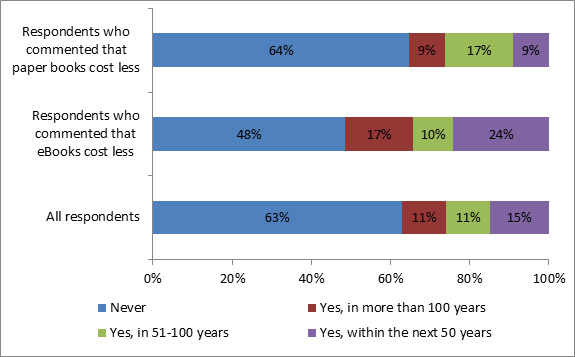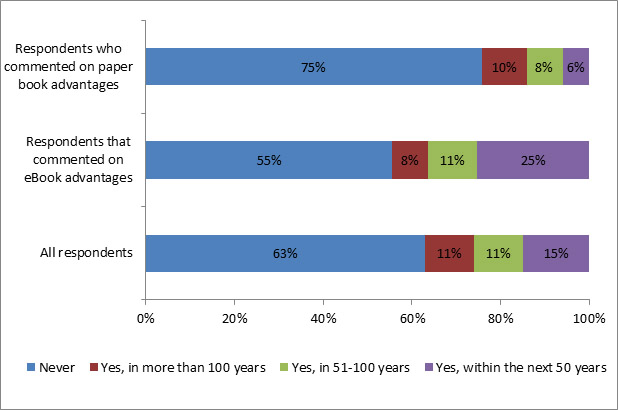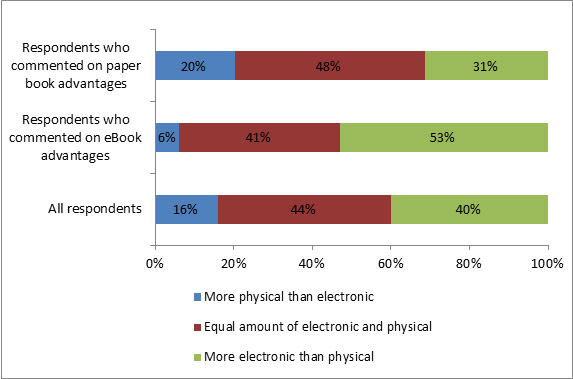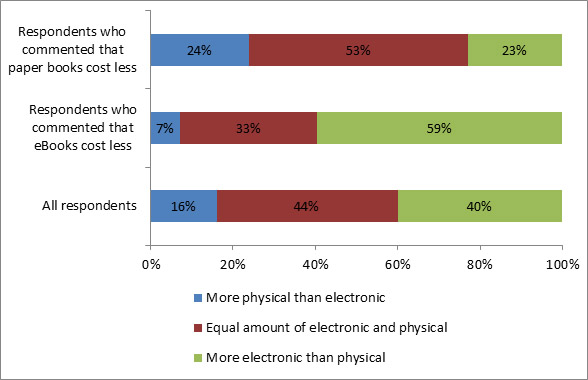With the advent of e-readers, such as the Kindle, Sony Reader Touch, and the Barnes & Noble Nook, many people are discussing what this new reading method means for print formats. Is it the beginning of the end for paper books? Will paper books and electronic formats exist together? Or are electronic books and reading devices just a fad that will eventually fade?
The Library Research Service’s (LRS) recent 60-Second Survey: The Future of the Book asked respondents what they thought of electronic and print formats and how those formats might change in the future. The survey was advertised on several librarian listservs, the Library Research Service website and blog, and the American Library Association weekly e-newsletter. More than 1,300 respondents participated and 947 of them (71%) also left comments, further explaining their thoughts on the future of the book. The majority of the comments were thoughtful and passionate, revealing a high level of interest in this topic. The comments were analyzed and 6 themes emerged addressing various influences on format: multiple formats will coexist, technological advantages, emotional and aesthetic draw to paper books, content is king, and generational change.
Definition of Comment Categories
- Multiple formats will coexist: the belief that several formats will be used in the future
- Technological advantages: advantages based on format of e-books versus paper books
- Emotional/aesthetic draw to paper books: the relationship and attachment to the physicality of the paper book
- Content is king: the argument that content will dictate format
- Cost: the production cost and/or retail price of e-books versus paper books
- Generational change: a shift will occur over time and with new generations
In this Fast Facts, the comment analysis in general is described, as well as what respondents said about technology and cost, and how those comments relate to other survey question responses. For more about the survey results and an analysis of the other comment categories, see the second in this series of Fast Facts: The Future of the Book, Part 2: Beyond the Bathtub, Personal Preference Among Many Factors Influencing Format Choice.
Comment Analysis
The comments were tagged for each theme they fell into (many comments discussed more than one theme). The categories of technology and cost were further tagged as pro-paper book, pro-e-book, or neutral, if they did not clearly indicate which format was believed to be superior. Chart 1 shows the number of times a comment was tagged in each category. The 2 most frequently discussed categories were “multiple formats will coexist” (431 comments) and “technological advantages” (340 comments).
As mentioned before, comments that discussed technology and cost were tagged based on the format advocated. These comments are discussed in this Fast Facts due to their “e-books versus paper books” approach to the future of the book discussion.
Chart 1
Future of the Book:
Number of Comments Tagged by Category
Technological Advantages
More than 1 in 3 comments (36%) discussed the technological advantages of e-books or paper books. The majority of these comments (62%) discussed paper book advantages, while only 26 percent discussed e-book advantages, and the final 10 percent were neutral (generally mentioning advantages of both formats). Comments that discussed the technological advantages of paper books frequently pointed out that paper books are a durable format, they can be used without electricity or batteries, and that paper books are easier on the eyes. Comments that discussed e-books mentioned the convenience, portability, and various enhancements of e-books.
“Books are a cheap, simple, durable, transferable, and persistent technology. Most e-books I have seen so far meet none of these criteria.”
Respondents tagged as commenting on technological advantages were compared with responses to 2 survey questions which asked respondents about their predictions for paper books and libraries (“Do you think paper books will eventually disappear?” and “What do you predict libraries will circulate in 10 years?”). The results of these questions from all respondents revealed that almost 2 in 3 respondents (63%) did not believe paper books will ever disappear. Much smaller percentages believed books will disappear in 100 years or more (11%), within 51-100 years (11%), or within the next 50 years (15%). Regarding what respondents predict libraries will circulate 10 years from now, an almost equal percentage of respondents predicted more electronic materials than physical (40%) and an equal number of electronic and physical materials (44%). The remaining 16 percent predicted physical items will continue to predominate in libraries.
“Books will always have a place, but I find with the enhancements made with electronic format… has made me a convert… I foresee vast educational uses for this format – easy access to references and background information, plus it would be helpful for an array of special education reading problems.”
However, among respondents tagged as commenting on technological advantages the response to these questions was slightly different. Three out of 4 respondents (75%) that discussed the advantages of paper books think the paper book will never disappear (see Chart 2). Just over half of the respondents that discussed e-book advantages (55%) agree that paper books will never disappear. However, 1 in 4 of those that discussed e-book advantages (25%) predict the book will disappear within the next 50 years.
Chart 2
Future of the Book:
Respondents Comments on Technological Advantages Compared to
If Paper Books Will Ever Disappear
Almost 1 in 2 of those that commented on the paper books’ advantages (48%), did however, predict that libraries would circulate an equal amount of paper and electronic materials 10 years from now (see Chart 3). Although these respondents believe the paper book is currently superior, they do anticipate libraries will greatly increase their electronic collections. On the other hand, the majority of those that commented on e-books’ advantages (53%) predict electronic materials to surpass physical materials in the next 10 years.
“It is sad, but I think it is going to change greatly in the next 20 years. I think eventually the printed book will disappear. Cost, convenience and new generations will all make the move to electronic happen.”
Chart 3
Future of the Book:
Respondents Comments on Technological Advantages Compared to Prediction of Formats Libraries Will Circulate in 10 Years
Cost
In addition to technology, several comments (116) discussed the cost of paper and electronic formats. As with technology, there were comments on both sides of the argument. Sixty-four percent of these comments indicated that paper books were the less expensive format, while 25 percent said this was true of e-books, and 11 percent mentioned cost, but did not indicate which format was most cost effective.
“The cost of the machines [e-readers] is prohibitive…Libraries can become too heavily invested in electronics and the cost of having to replace all the outdated technology that keeps being replaced by newer technology. There is not enough money for libraries to supply everything to everybody.”
Again, the responses to the survey questions “Do you think paper books will eventually disappear?” and “What do you predict libraries will circulate in 10 years?” were compared with the respondents that were tagged as commenting on cost. The majority of respondents (64%) that commented on the lower cost of paper books also believed that paper books will never disappear (see Chart 4). Forty-eight percent of those that commented on the lower cost of e-books agree that paper books will never disappear, but the second largest group in this category (24%) believe paper books will disappear within the next 50 years. Their thoughts on the cost effectiveness of the e-book may be one reason why. Those that argued that the paper book is less expensive are very similar to the response received from all respondents; though a higher percentage from the overall response believed paper books will disappear within the next 50 years (15%).
Chart 4
Future of the Book:
Respondents Comments on Cost Compared to If Paper Books Will Ever Disappear

“The book is durable and economically less costly than e-books or audio books. Thus, I feel that their continued survival is pretty much guaranteed.”
Among the respondents that commented on the lower cost of paper books, more than 1 in 2 (53%) still predict that libraries will circulate an equal number of electronic and physical materials in 10 years and 24 percent predict libraries will circulate more electronic materials than physical materials (see Chart 5). Similar to those that discussed the technological advantages of paper books, these respondents still believe the disparity between physical and electronic materials in libraries will decrease regardless of which format they believed more cost effective. Only the remaining 24 percent anticipate more physical than electronic materials. Unsurprisingly, the majority of respondents that argued the lower cost of e-books (59%) expect more electronic materials and only 7 percent of this group believe physical materials will still outnumber electronic materials 10 years from now.
Chart 5
Future of the Book:
Respondents Comments on Cost Compared to Prediction of Formats Libraries Will Circulate in 10 Years
Conclusion
The future of the book is certainly an issue respondents felt strongly about. The comments revealed the important issues of technological advantages and cost of both formats. Although many respondents believe paper books to be superior in technology and cost, the majority still predict a shift in the formats libraries will circulate. With 44 percent of all survey respondents expecting an equal number of physical and electronic materials in libraries, it is no surprise that the most frequently cited theme in the comments was that multiple formats will exist in the future. In the second in this series of Fast Facts, this comment category will be analyzed, as well as the emotional/aesthetic draw to paper books, content is king, and generational change. Interesting differences in how respondents answered survey questions based on the type of library they work in and if they own an e-reader are also examined.



